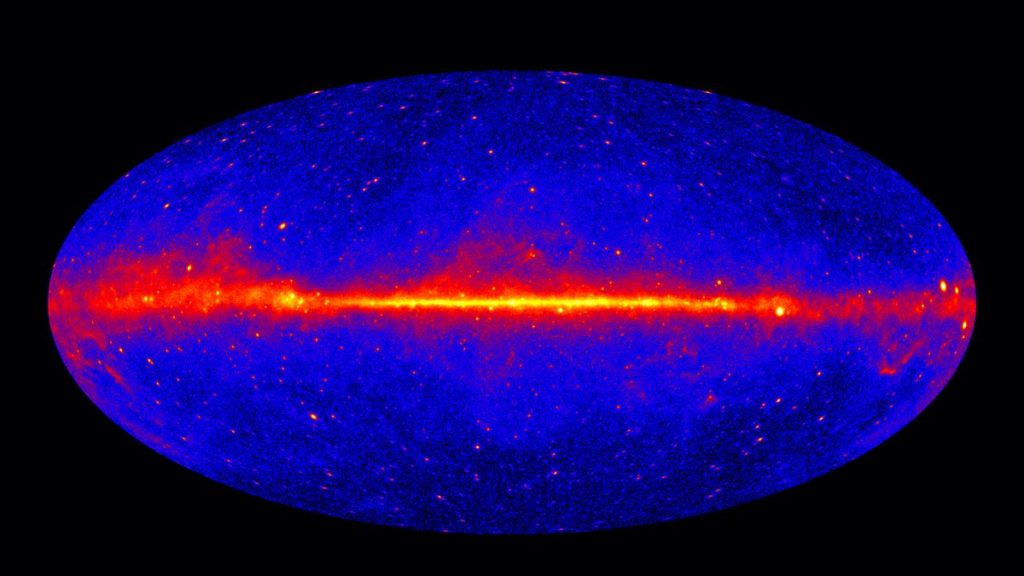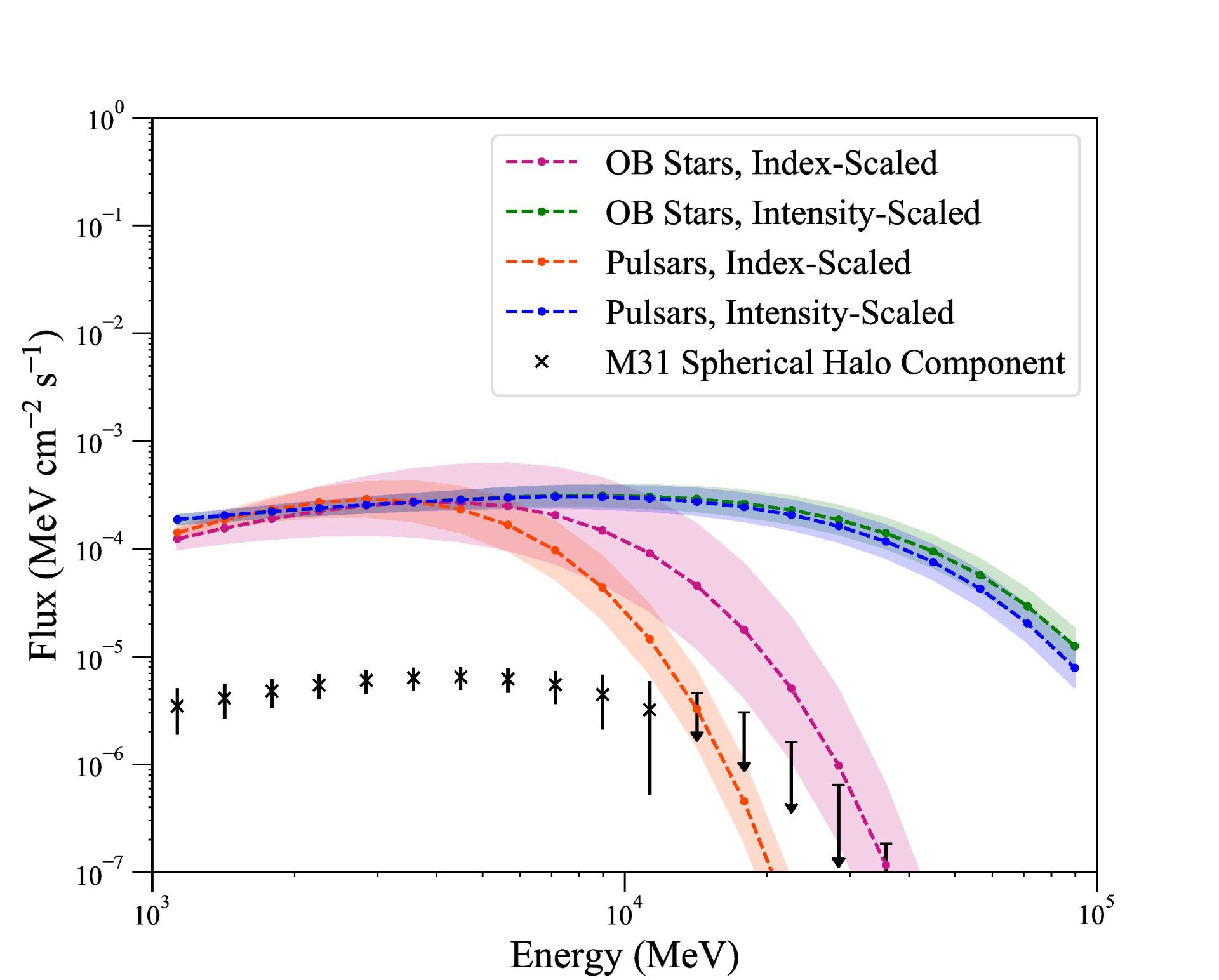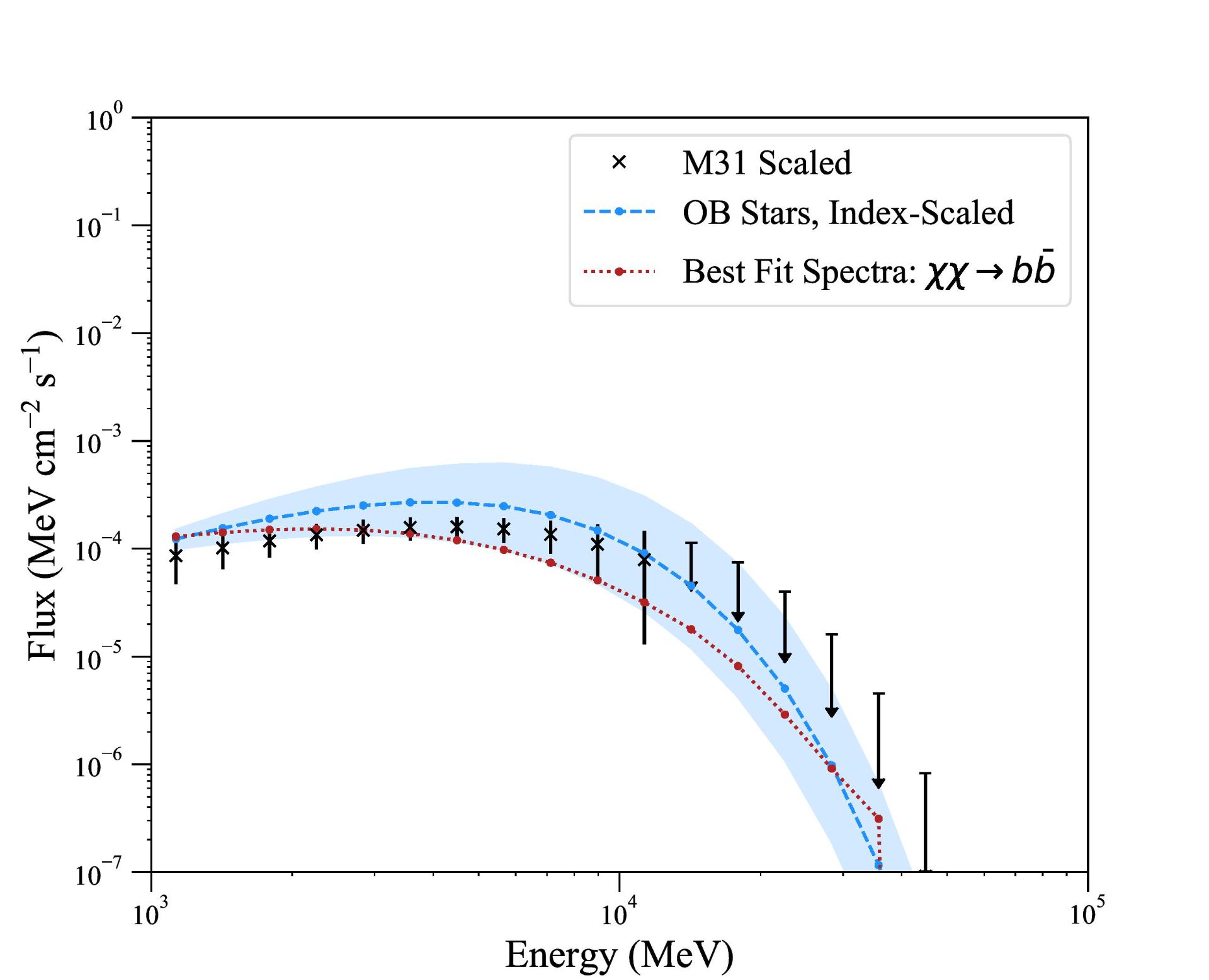Dark Matter
More than 80 years ago, the German physicist Fritz Zwicky theorized the existence of an invisible substance whose gravity holds galaxies together. He called it Dunkle Materie: Dark Matter – and to this day we have no great theory for what it might be. We have written about dark matter on our blog before and this article gives some further background. Long story short: dark matter is all around us, it does not interact with light, and it dominates the regular matter in our universe by about 5 pounds of dark matter to every 1 pound of regular matter. It is believed to make up a large sphere (or halo) around every galaxy that is densest at the galactic center.
So, how can we make a definitive detection of dark matter and understand what it is? We can infer its existence by studying the rotation curves of galaxies and the large scale structure of the universe, and through gravitational lensing observations. But all of these experiments probe the large “bulk” nature of dark matter. What we would like is an experiment that can probe the “particle” nature. After all, what we really want is to identify the particle(s) that make up dark matter, so we can predict new interactions between dark matter and the particles we are familiar with. The problem is that it just interacts with regular matter so weakly (if at all), that experiments on earth have yet to see it.
What we know pretty definitively is that dark matter does not reflect or absorb light photons at all – hence, dark. However, it is possible that it may annihilate with itself to produce other Standard Model particles, such as bottom quarks or taus, and these particles could then decay into photons which we can easily detect. So if two dark matter particles can annihilate and produce known, detectable particles, then the dark matter will produce light indirectly; physicists call this avenue of detection indirect detection. We then look to where we expect a lot of dark matter, and see if there is any extra light which we can’t trace back to regular matter.
So, where might we expect dark matter to congregate? At the core of every galaxy.
About 10 years ago, an unexplained and significant excess of photons was observed from the center of our galaxy. This Galactic Center Excess has long been theorized as the indirect product of dark matter annihilation. More recently, a photon excess from the Andromeda Galaxy has also been observed, and dark matter is again suspected. A pair of papers from UCI and the Fermi-LAT collaboration, co-authored by fellow UCI graduate student Anne-Katherine Burns, UCI professors Arvind Rajaraman and Simona Murgia, UCI alum Chris Karwin, myself, and other collaborators, studied these excesses to determine if they might be the result of dark matter.
Galactic Center and Andromeda Excess
The Fermi Gamma-ray Space Telescope is an instrument designed to capture high energy photons, and has been the primary instrument in observing the excesses from the Andromeda Galaxy (also known as M31) and our home galaxy, the Milky Way. Let’s take a look at the excess light which the telescope observed, and try to make sense of it.
The plot to the right overlays Fermi’s observations from the outer halo of M31 and the Milky Way. The y-axis is the photon flux observed, and the x-axis is the photon energy; in other words, how much light was detected at various energies. This measurement is known as the light spectrum. The 4 colored lines are data from the Milky Way’s galactic center, and the black data points are from the outer halo of M31. This plot has had the background light produced by regular matter subtracted off, such that the data you see is the unexplained excess from each source. The background light is estimated
by 4 different models based on OB stars and pulsars, and each of these can be further specified by index or intensity scaling. The details of these background models are not too important, but it is worth noting that the galactic center excess has more disparity from model to model as compared to M31; this is because the center of the Milky Way is much more crowded with stars, as compared to the outer halo of M31. The 4 colored bands describe the uncertainty in our Milky Way background models, meaning the true excess could lie anywhere in between. The blue and green models possess a “high-energy tail” – meaning that these models predict much more light at higher energies.
A couple things to notice:
- The observed Milky Way Excess is much brighter; this makes sense as the center of the Milky Way is expected to have more dark matter than the outer halo of M31
- Each of the excesses have a similar spectral shape.
- The peak excess occurs at about the same energy for each galaxy.
These features suggest that the same mechanism might be creating this light in each galaxy. If these signals are the result of dark matter annihilation there are 3 things we need to determine:
- How does dark matter annihilate?
- What is the mass of the dark matter particle?
- How much dark matter is in the telescope’s field of view? The more dark matter the telescope is looking at, the greater the expected signal.
In our papers we simulate the production of photons from dark matter annihilation and compare to the telescope’s observation.
Simulating Dark Matter Annihilation
It turns out that it is relatively easy to guess a model for dark matter annihilation. The particle physics of any interaction is dictated by a mathematical quantity known as the “Lagrangian” that must obey some strict rules and symmetries. If we knew exactly how dark matter behaved, then we could write down the Lagrangian exactly, and we could calculate anything we want about dark matter. We don’t know this exact Lagrangian (of course),
but we can still propose a simplified model that might capture the broad strokes of the complete theory. In our paper, we propose a few simple models that describe how dark matter could annihilate and create regular particles; we studied models where 2 dark matter particles annihilate into 1 or 2 pairs of quarks. We then simulate millions of dark matter annihilations and see what light spectra come out.
One of the softwares we use to simulate these spectra is called “PPPC 4 DM ID” : A Poor Particle Physicist Cookbook for Dark Matter Indirect Detection. Using one of our simple models, it calculates the light spectra given a dark matter particle’s mass. We simulate annihilations for various dark matter masses and compare these spectra to our telescope’s observations to find the mass that best reproduces the data. We also rescale the M31 dataset to best match the Milky Way data. This accounts for the fact that M31 may have more or less dark matter in it. If the excesses are truly from dark matter annihilation we would expect the simulated spectra, the rescaled M31 excess, and the Milky Way excess to line up.
After calculating the annihilation spectra, we compare to the data. The plot to the right combines the Milky Way excess (blue shaded region), the M31 excess (black), and the light spectra resulting from 2 dark matter particles annihilating into two bottom quarks, which subsequently produce light (red). You can tell visually, that the simulation is able to reproduce both excesses within measurement errors. The Milky Way excess shown here is the pink model from the first plot (this model showed the best agreement with the annihilation spectra and the M31 excess) – the models with the high-energy tail did not fit the dark matter models very well. This suggests that the high-energy tail is not consistent with dark matter annihilation, and needs further analysis to understand whether it is the result of dark matter, or if it is just some regular matter process we don’t quite understand.
Ultimately, our analyses determine the dark matter mass that best fits the data, as well as how much brighter the excess signal from the Milky Way is, compared to M31. For the model shown in the second plot, we returned a particle mass of 46 GeV (less than a trillionth of a trillionth of a pound) and deduced that the Fermi-LAT telescope observed a signal that is about 40 times brighter in the Milky Way’s galactic center than in M31’s outer halo. These results are useful for other physicists and astronomers who wish to relate the excesses to dark matter, and it helps them understand which models are compatible with these excesses.
While our simulations produce a good fit to the data, there is much doubt in the community over these excesses. Is there really an excess, or did our background models fail to capture some conventional source? One possibility is that millisecond pulsars, which are difficult for our telescopes to resolve, are producing these excesses. Another is that we have poorly modeled the gas in these galaxies, giving us an inaccurate view of the background. The next step for astronomers is to improve observational techniques and background models. As our telescopes and methods improve, evidence will gather that either supports or refutes the excess of light emanating from each galaxy. We may find that we can reproduce these excesses with better modeling of conventional light sources, or we may find that we cannot reproduce this light and new physics awaits a discoverer.
You can find the original papers here and here.
Post by Max Fieg, graduate student working on his PhD in Particle Physics at UCI.
Edited by Kevin Greif, Alex Broughton


